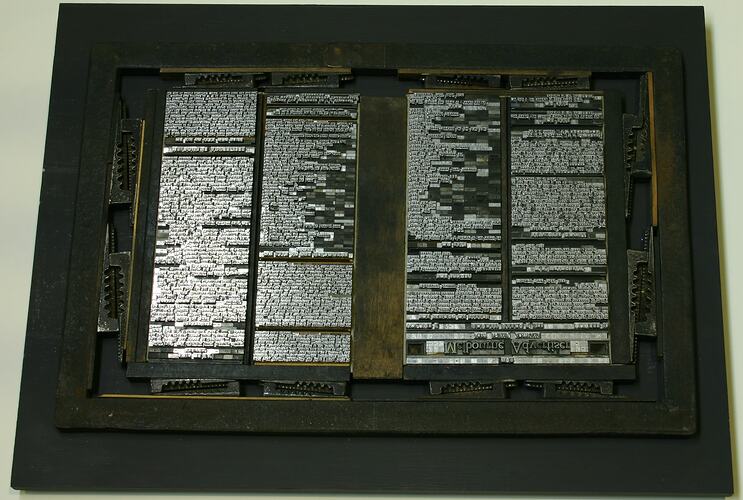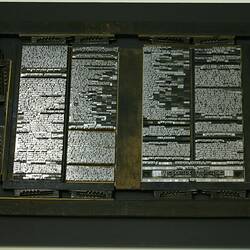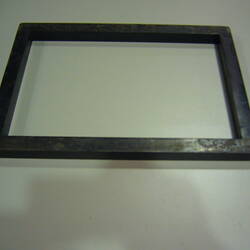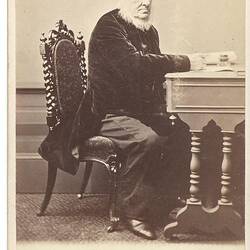Summary
This is a printing forme handset with monotype, using 19th century type and typesetting items.
The type has been set up to reproduce the first page and other sections of the first printed edition of the Melbourne Advertiser, published in 1838. The complete forme and content was assembled for the Fawkner Press display in the Melbourne exhibition, 2008.
The empty frame is known as the chase. The chase filled with a job for printing is known as the forme.
The forme, quoins and spacers were originally used in printing the Dimboola Banner. The monotype was already in the Museum collection, and was acquired from the Victorian Government Printing Office.
The complete forme and content was assembled for the Fawkner Press display in the Melbourne exhibition, 2008.
The first page is as the original but the second page is not complete. Printing historian Peter Marsh has set the type, which includes an acknowledgment of his own role. Fawkner used foundry type; monotype was not available then. Foundry type is cast differently from monotype. Only the title heading is in foundry type.
Setting type by hand is known as 'composing the type'.
The type is taken letter by letter and placed into a 'setting stick' -- a wood or metal tray held in one hand and the words are built into lines of type of a set width.
The lines are then put together to make a page inside a metal frame called a "chase". Spaces in amongst the page are filled with wooden or metal "furniture". The furniture is level with the surfaces of the type blocks so as not to pick up any ink. The spaces between the chase walls and the page are filled with expandable "quoins". Quoins, when tightened, lock all the type and furniture securely within the chase (now called a "forme").
The forme is placed on the press and printing commenced.
Physical Description
The forme with newspaper handset in monotype consists of a. one forme b. 4 pairs large quoins c. 8 pairs small quoins d. 24 different sized wooden and metal spacers e. monotype and foundry type The forme is a rectangular frame made of metal. Each pair of quoins consist of two pieces of serrated metal that can be progressively tightened Spacers are strips of different length and thickness, some made of metal and others of wood.
Significance
This item (apart from the type) was donated by the Dimboola & District Historical Society to enable Peter Marsh, Research Associate, to set up type for the Fawkner Press display in the Melbourne exhibition. The type has been set up to reproduce the first page and other sections of the first printed edition of the Melbourne Advertiser. The first page is as the original but the second page is not complete. Peter Marsh has included his own acknowledgment in the second page so that there can be no mistake as to its provenance. Fawkner used foundry type; monotype was not available until the 1840s. Foundry type is cast differently from monotype. Only the newspaper title of the 'replica' is in foundry type.
The items making up the content of the forme (apart from the type) were originally used in the printing of the Dimboola Banner newspaper. The contents of the newspaper office were donated in situ to the Dimboola Historical Society in 2004 and became part of the collection of the Dimboola Banner Printing Museum, which is owned by the Society (the building was purchased for the Society). The items were then donated to the Museum by the Dimboola & District Historical Society.
The newspaper office closed when the Dimboola Banner was sold and production shifted to another town with more modern equipment. The paper ceased to be printed with letterpress in the mid 1980s.
It is not possible to date the items or to determine their provenance as equipment came from various sources, for example from other local newspapers that closed down. The 'material' could be dated anywhere from 1879, which is when the first issue of the newspaper came out. They can be described as examples of 19th century technology.
More Information
-
Collecting Areas
-
Acquisition Information
Donation from Mr Dale Conway - Dimboola Historical Society, 01 Jul 2007
-
Assembler
Mr Peter Marsh, Melbourne, Greater Melbourne, Victoria, Australia, 2007
-
Inscriptions
Melbourne Advertiser/(and other text)
-
Classification
-
Category
-
Discipline
-
Type of item
-
Overall Dimensions
35.5 cm (Length), 53 cm (Width), 1 cm (Height)
Base: 45.00 L x 58.50 W x 1.60 H.
-
References
[Link 1] accessed 9 October 2008 Melbourne Advertiser first printed edition (#10)
-
Keywords






